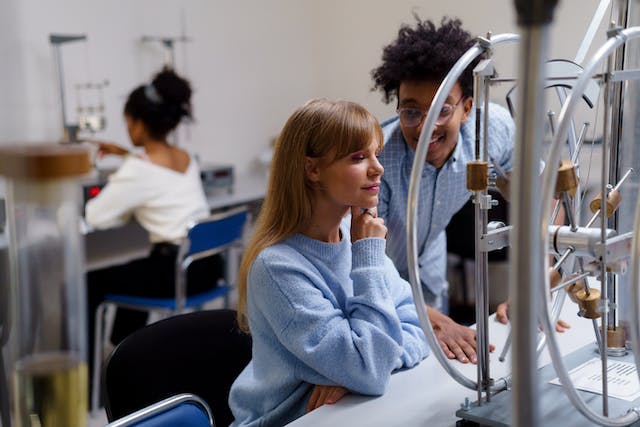The introduction of online learning has caused a significant upheaval in the educational environment. The issue in transforming conventional classrooms into virtual environments is to keep students engaged and provide a dynamic learning environment. One important answer is interactive learning, which provides a variety of methods to hold students’ interest, improve understanding, and encourage active engagement. We will look at a number of interesting online teaching strategies in this post that use interaction to make learning more meaningful.

Gamification: Bringing Education to Life:
Points, badges, and leaderboards are examples of game features that are included into the learning process via gamification. This encourages pupils to reach their objectives while also adding a fun factor. Learning may be made more fun and engaging by creating educational games that are specifically tailored to teach ideas, reinforce skills, and provide immediate feedback.
Virtual labs and interactive simulations:
A hands-on learning experience in disciplines that often need physical experimentation is provided via simulations and virtual laboratories. For example, students may control virtual experiments, see the results, and make inferences in scientific and engineering classes. This not only improves comprehension but also offers an affordable and secure means of carrying out research.
Talk boards and cooperative education:
Students may have meaningful discussions, exchange ideas, and work together to solve issues in an environment created by online discussion forums and collaborative platforms. Peer-to-peer learning and a feeling of community are promoted by these platforms. Teachers have the ability to lead conversations, ask challenging questions, and assist pupils in examining other viewpoints.
Engaging Multimedia Information:
Multimedia components like animations, interactive presentations, and movies improve the educational process. Stimuli that are both visual and audible may greatly enhance memory retention. Educators may design captivating classes that accommodate diverse learning styles with the help of platforms that facilitate multimedia material.
In-the-moment Surveys and Questions:
Incorporating real-time polls and quizzes into asynchronous learning or live sessions encourages student participation. This method evaluates understanding while also enabling teachers to modify their strategy in response to real-time input. Surveys may be used to find out what people think, start conversations, and add interaction to the classroom.
Virtual and Augmented Reality (AR/VR):
Immersion-based learning is made possible by AR and VR technology in online learning. These technologies provide a degree of involvement that goes beyond conventional teaching techniques, whether it is via the exploration of historical locations, the dissection of virtual creatures, or the simulation of complicated settings. Even though they are still developing, AR and VR have the potential to completely transform online learning by producing realistic, captivating settings.
Adaptive Learning Platforms:
Using technology, adaptive learning systems customize learning opportunities according to each student’s performance and development. These platforms evaluate information about how students engage with the material and modify the level and tempo appropriately. With this tailored approach, every student is guaranteed a demanding yet doable educational experience.
Peer Review and Feedback:
Giving students peer review tasks encourages them to take an active role in assessing the work of their peers. This fosters the development of analytical and critical thinking abilities as well as a feeling of ownership over one’s own education. Peer criticism that is constructive may increase comprehension and raise the quality of students’ work overall.
Live Sessions that are Synchronous:
Real-time hosting of live sessions gives students and teachers the chance to communicate directly. Teachers may arrange Q&A sessions, provide online lectures, and have discussions by using video conferencing solutions. These in-person meetings provide a feeling of community, making students feel more invested in their education and offering a forum for prompt question answers.
Case studies and storytelling:

Online courses using real-world case studies and narrative incorporate a human aspect into the learning process. Narratives has the ability to engross pupils and make complex ideas more approachable. By applying theoretical information to real-world scenarios, case study analysis helps students get a better comprehension of the material.
Individual Learning Journeys:
Since every learner progresses at a different rate, individualized learning pathways allow students to go through the course material in accordance with their comprehension and level of proficiency. Through the customization of the learning process to meet the requirements of each individual student, this adaptive method fosters a more successful and individualized learning journey by preventing students from feeling hurried or held back.
Modules for Microlearning:
Microlearning is supported by information that has been divided into smaller, more manageable chunks. Delivering condensed, focused lessons that meet certain learning goals is the main goal of this strategy. Because they can be completed in short periods, microlearning modules are especially good at holding students’ attention and helping them manage their time and stay focused.
Interactive Whiteboards & Tools for Annotation:
Interactive conversations and cooperative problem-solving are made possible by virtual whiteboards and annotation tools. With the help of these technologies, teachers may clarify ideas, work through issues quickly, and get students involved by having them annotate diagrams or add to shared papers. This dynamic visual interaction improves comprehension and memory of the material.
Soft Skills Online Simulations:
Through interactive simulations, online education may support the development of soft skills in addition to technical knowledge. In order to better prepare students for real-world situations, communication, cooperation, and decision-making simulations may help them hone these crucial abilities in a virtual setting.
Ongoing Evaluation and Comments:
Throughout the course, frequent quizzes, evaluations, and feedback loops are included to make sure students understand their progress and remain on course. A culture of ongoing development and active engagement is fostered by continuous assessment, which gives teachers and students insights into areas that may need more attention.
Personalized Learning Analytics:
Learning analytics integration enables instructors to monitor and assess how students engage with web material. Through the use of statistics on performance, completion rates, and engagement, educators may pinpoint areas for growth and modify their pedagogical approaches. A more data-driven and flexible approach is made possible by personalized learning analytics, which guarantees that interventions are tailored to each learner’s specific requirements.
Buddy Systems and Peer Mentoring:
Creating buddy networks and peer mentorship programs helps to create a positive online learning environment. Assisting students by matching them with more seasoned classmates or study partners promotes cooperation, knowledge exchange, and the development of a feeling of community. This method not only improves the educational process but also gives students access to a network of emotional and intellectual support.
Speakers and Virtual Field Trips:
Real-world experiences are incorporated into online learning environments via virtual field excursions and guest speaker events. Students may experience historical locations, museums, and industrial settings via virtual tours, giving them a hands-on connection to the material. The learning process is enhanced by the perspectives, experiences, and connections made by guest speakers from related sectors between theoretical ideas and real-world implementations.

Apps for Mobile Learning:
Mobile learning apps are a useful tool for interactive education since cellphones are so widely used. With the help of these applications, students may access educational resources while they’re on the road and interact with the subject whenever it suits them. Mobile-centric lives are catered to with interactive quizzes, flashcards, and discussion forums, which encourage ongoing involvement.
Service Learning and Community Projects:
Online courses that include community initiatives and service learning opportunities enable students to apply their knowledge in practical settings. In addition to improving the practical application of learning, working on projects with neighborhood groups or taking part in virtual service learning opportunities fosters a feeling of social responsibility and community involvement.
Ongoing Professional Growth for Teachers:
For interactive learning strategies to be used effectively, educators must continue their professional growth. Online education is always improving because to training programs that emphasize using new technology, honing online teaching techniques, and integrating student feedback. Teachers who have access to the newest resources and techniques are in a better position to design stimulating and productive learning environments.
In summary:
Interactive learning strategies are essential for sustaining student interest and advancing successful learning outcomes as online education develops. A varied and dynamic virtual classroom is produced via the combination of gamification, simulations, multimedia material, and collaboration tools. Adopting these interactive strategies will help teachers make sure that students, in a variety of topics and learning contexts, continue to find online learning effective, entertaining, and educational.



